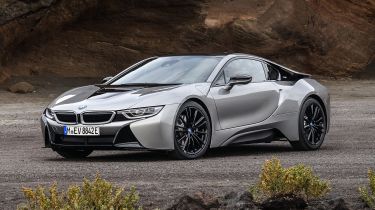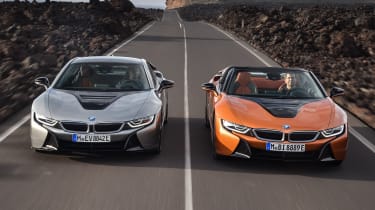BMW i8 (2014-2020) review - MPG, CO2 and running costs
You’ll never match the i8’s claimed mpg figure in the real world, but you’ll still enjoy small car running costs – mostly

The i8 Coupe’s official figures sit at 128.4mpg and 42g/km of CO2, while the Roadster returns the same combined economy figure but emits 46g/km of CO2. These fuel economy figures are almost impossible to achieve in the real world, but you’ll definitely improve considerably on what you’d get from a 911 or an R8 – not least because the i8 is capable of driving up to 34 miles on battery power alone. During our time with the car we returned nearly 40mpg, although that included plenty of hard driving.
However, as with all plug-in models, the running costs will depend very much on how you use the i8. If you use it for a short daily commute and have access to a charging point, you could save thousands at the pumps by mainly using the battery. And the savings don’t end there.
Company car buyers will benefit greatly. When the i8 was introduced in 2014 it sat in the 5% BIK band, meaning company car tax could be as low as £998 per year. Sadly (and predictably) it’s now in the 13% band (for 2018/2019) and will shift up to 16% for 2019/2020 – but that still significantly undercuts traditional sports car rivals.
It’s imperative that i8 owners manage their battery charges in order to make the most of the drivetrain’s fuel savings. Like all batteries these ones go flat – and quite quickly if you’re heavy footed – which means that at times the i8 will be running on its petrol engine alone, and consequently will feel notably slower. Both the engine and regenerative braking can regenerate the battery, but it’s always better to keep the battery topped up by plugging it in.
Used - available now

2018 Mazda
6 Saloon
26,134 milesManualPetrol2.0L
Cash £14,063
2020 MINI
Countryman
31,160 milesAutomaticDiesel2.0L
Cash £16,587
2018 BMW
X5
48,752 milesAutomaticDiesel3.0L
Cash £24,606
2020 Volvo
XC60
53,700 milesAutomaticPetrol2.0L
Cash £20,406Plugged into a standard household supply, the i8 takes around eight hours to charge from flat, though with a special BMW-supplied wall box an 80 per cent charge can be achieved within two hours. Most BMW dealerships have one or two of these available too, so any i8 owner can pop in and top up using their special recharging card. The ever-growing network of public charging stations can prove useful as well, of course.
As a plug-in hybrid, the i8 does without the range anxiety of traditional electric cars. With its 32-litre fuel tank onboard it can theoretically cover just over 300 miles on a full charge and with a full tank.
Insurance groups
As you’d expect, the BMW i8 is in the top category for insurance in the UK – group 50. So, while fuel and tax costs may be in the family hatchback leagues, insuring an i8 is another matter altogether – one for a specialist high-performance car insurer, most likely.
That’s partly to do with its performance and desirability to thieves, but also repair costs – the engine may be common, but the CFRP chassis and carbon body parts are not cheap to repair.
BMW offers bespoke in-house insurance for i8 drivers, but as ever you need to shop around to make sure you’re getting the best deal.
Depreciation
Our experts expect the i8 to retain around 55 percent of its new value after three years. This is a car that will remain desirable for many years to come, and that figure is in keeping with the Audi R8 and comparable higher-end versions of the Porsche 911.








